fuel cap MERCEDES-BENZ G-CLASS SUV 2008 Owners Manual
[x] Cancel search | Manufacturer: MERCEDES-BENZ, Model Year: 2008, Model line: G-CLASS SUV, Model: MERCEDES-BENZ G-CLASS SUV 2008Pages: 293, PDF Size: 4.49 MB
Page 9 of 293
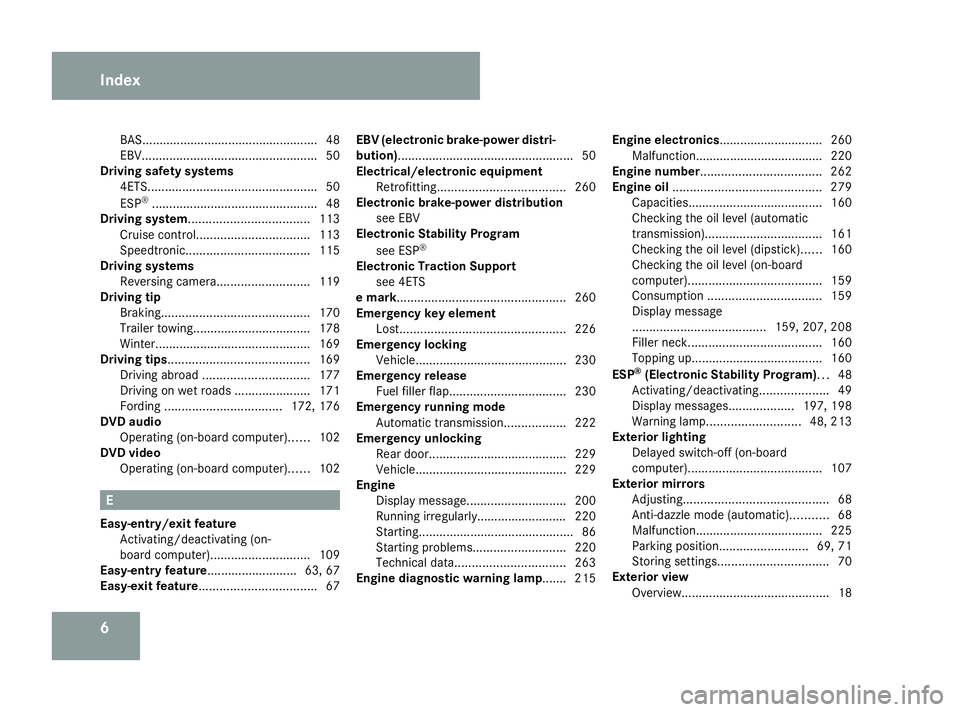
6BAS.
.................................................. 48
EBV. .................................................. 50
Driving safety systems
4ETS. ................................................ 50
ESP ®
................................................ 48
Driving system................................... 113
Cruise control. ................................ 113
Speedtronic. ................................... 115
Driving systems
Reversing camera. ..........................119
Driving tip
Braking ........................................... 170
Trailer towing. ................................. 178
Winter ............................................. 169
Driving tips......................................... 169
Driving abroad ............................... 177
Driving on wet roads ......................171
Fording .................................. 172, 176
DVD audio
Operating (on-board computer). .....102
DVD video
Operating (on-board computer). .....102 E
Easy-entry/exit feature Activating/deactivating (on-
board computer). ............................ 109
Easy-entry feature ..........................63, 67
Easy-exit feature.................................. 67EBV (electronic brake-power distri-
bution)
................................................... 50
Electrical/electronic equipment Retrofitting ..................................... 260
Electronic brake-power distribution
see EBV
Electronic Stability Program
see ESP ®
Electronic Traction Support see 4ETS
e mark................................................. 260
Emergency key element Lost. ............................................... 226
Emergency locking
Vehicle............................................ 230
Emergency release
Fuel filler fla p.................................. 230
Emergency running mode
Automatic transmission ..................222
Emergency unlocking
Rear door. ....................................... 229
Vehicle............................................ 229
Engine
Display message ............................. 200
Running irregularl y.......................... 220
Starting ............................................. 86
Starting problems ........................... 220
Technical data. ............................... 263
Engine diagnostic warning lamp....... 215 Engine electronics.............................. 260
Malfunction..................................... 220
Engine number................................... 262
Engine oil ........................................... 279
Capacities.. ..................................... 160
Checking the oil level (automatic
transmission) .................................. 161
Checking the oil level (dipstick). .....160
Checking the oil level (on-board
computer). ...................................... 159
Consumption ................................. 159
Display message
....................................... 159, 207, 208
Filler neck. ...................................... 160
Topping up. ..................................... 160
ESP ®
(Electronic Stability Program)... 48
Activating/deactivating ....................49
Display messages ...................197, 198
Warning lamp. .......................... 48, 213
Exterior lighting
Delayed switch-off (on-board
computer). ...................................... 107
Exterior mirrors
Adjusting .......................................... 68
Anti-dazzle mode (automatic). ..........68
Malfunction..................................... 225
Parking position. ......................... 69, 71
Storing settings ................................ 70
Exterior view
Overview. .......................................... 18Index
463_AKB; 1; 8, en-GB
wobuchh,
Version: 2.10.6 2008-07-17T15:19:41+02:00 - Seite 6Dateiname: 6515_4091_02_buchblock.pdf; preflight
Page 10 of 293
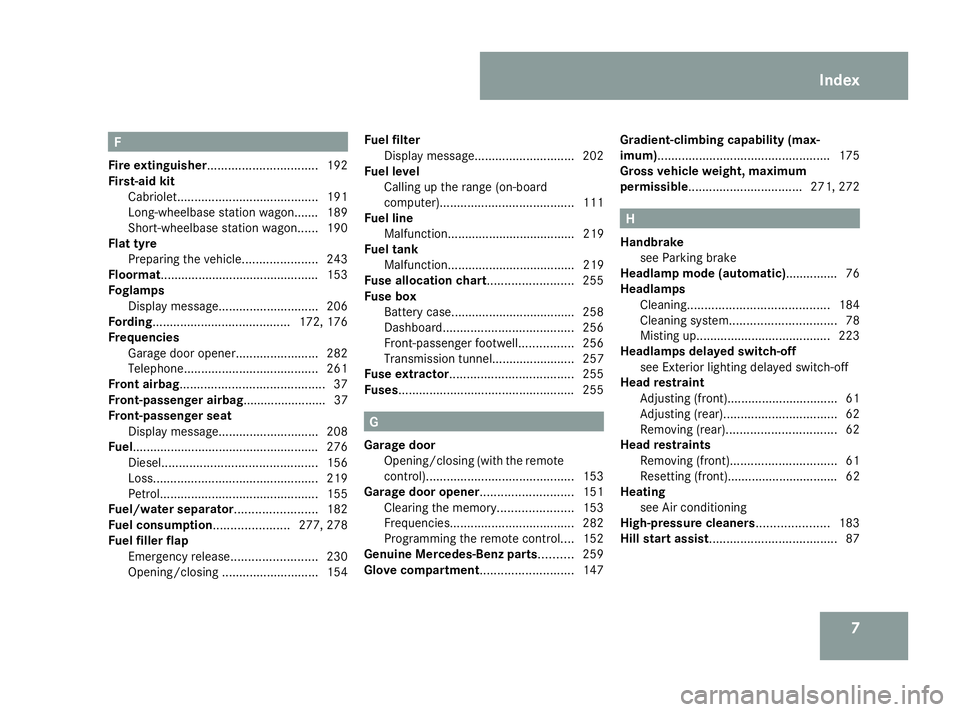
7F
Fire extinguisher................................ 192
First-aid kit Cabriolet. ........................................ 191
Long-wheelbase station wagon....... 189
Short-wheelbase station wagon. .....190
Flat tyre
Preparing the vehicle. .....................243
Floormat............................................. .153
Foglamps Display message ............................. 206
Fording........................................ 172, 176
Frequencies Garage door opene r........................ 282
Telephone. ...................................... 261
Front airbag .......................................... 37
Front-passenger airbag........................ 37
Front-passenger seat Display message ............................. 208
Fuel...................................................... 276
Diesel. ............................................ 156
Loss. ............................................... 219
Petrol .............................................. 155
Fuel/water separator........................ 182
Fuel consumption...................... 277, 278
Fuel filler flap Emergency release. ........................230
Opening/closing ............................ 154Fuel filter
Display message ............................. 202
Fuel level
Calling up the range (on-board
computer). ...................................... 111
Fuel line
Malfunction..................................... 219
Fuel tank
Malfunction..................................... 219
Fuse allocation chart......................... 255
Fuse box Battery case................................... .258
Dashboard. ..................................... 256
Front-passenger footwell ................256
Transmission tunnel........................ 257
Fuse extractor.................................... 255
Fuses................................................... 255 G
Garage door Opening/closing (with the remote
control) ........................................... 153
Garage door opener........................... 151
Clearing the memory. .....................153
Frequencies. ................................... 282
Programming the remote control ....152
Genuine Mercedes-Benz parts.......... 259
Glove compartment........................... 147Gradient-climbing capability (max-
imum)..................................................
175
Gross vehicle weight, maximum
permissible................................. 271, 272 H
Handbrake see Parking brake
Headlamp mode (automatic) ...............76
Headlamps Cleaning ......................................... 184
Cleaning system. .............................. 78
Misting up. ...................................... 223
Headlamps delayed switch-off
see Exterior lighting delayed switch-off
Head restraint
Adjusting (front) ................................ 61
Adjusting (rear). ................................ 62
Removing (rear). ............................... 62
Head restraints
Removing (front). .............................. 61
Resetting (front)................................ 62
Heating
see Air conditioning
High-pressure cleaners..................... 183
Hill start assist..................................... 87 Index
463_AKB; 1; 8, en-GB
wobuchh,
Version: 2.10.6 2008-07-17T15:19:41+02:00 - Seite 7Dateiname: 6515_4091_02_buchblock.pdf; preflight
Page 26 of 293
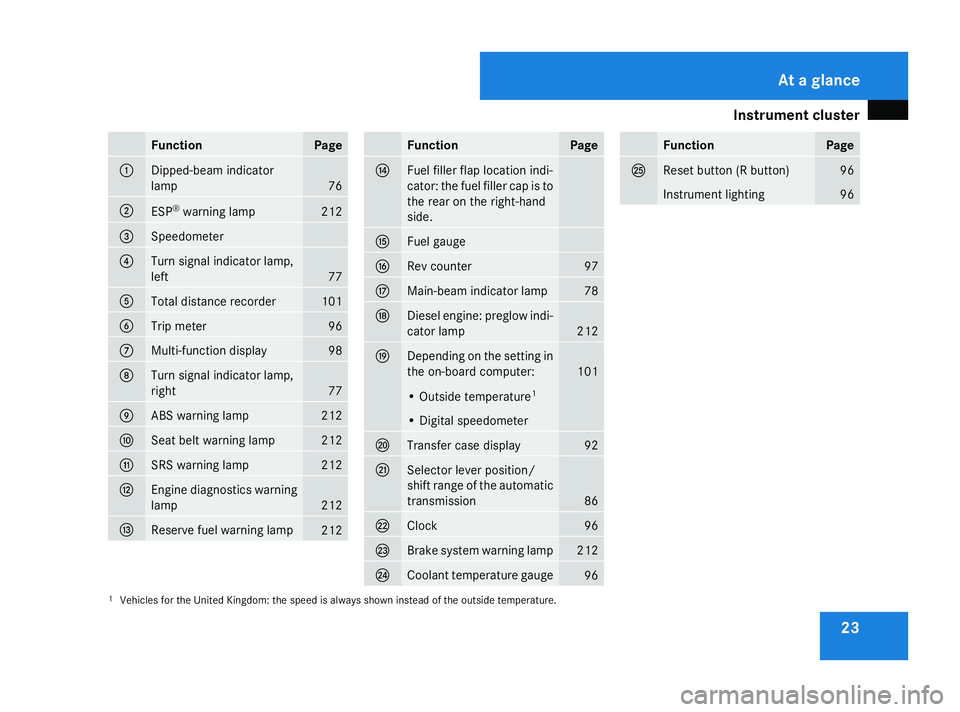
Instrument cluster
23Function Page
1
Dipped-beam indicator
lamp
76
2
ESP
®
warning lamp 212
3
Speedometer
4
Turn signal indicator lamp,
left 77
5
Total distance recorder 101
6
Trip meter 96
7
Multi-function display 98
8
Turn signal indicator lamp,
right 77
9
ABS warning lamp 212
a
Seat belt warning lamp 212
b
SRS warning lamp 212
c
Engine diagnostics warning
lamp
212
d
Reserve fuel warning lamp
212 Function Page
e
Fuel filler flap location indi-
cator: the fuel filler cap is to
the rear on the right-hand
side. f
Fuel gauge
g
Rev counter 97
h
Main-beam indicator lamp 78
j
Diesel engine: preglow indi-
cator lamp
212
k
Depending on the setting in
the on-board computer:
101
• Outside temperature
1 • Digital speedometer
l
Transfer case display 92
m
Selector lever position/
shift range of the automatic
transmission
86
n
Clock 96
o
Brake system warning lamp 212
p
Coolant temperature gauge
96 Function Page
q
Reset button (R button) 96
Instrument lighting 96
1 Vehicles for the United Kingdom: the speed is always shown instead of the outside temperature. At a glance
463_AKB; 1; 8, en-GB
wobuchh,
Version: 2.10.6 2008-07-17T15:19:41+02:00 - Seite 23Dateiname: 6515_4091_02_buchblock.pdf; preflight
Page 158 of 293
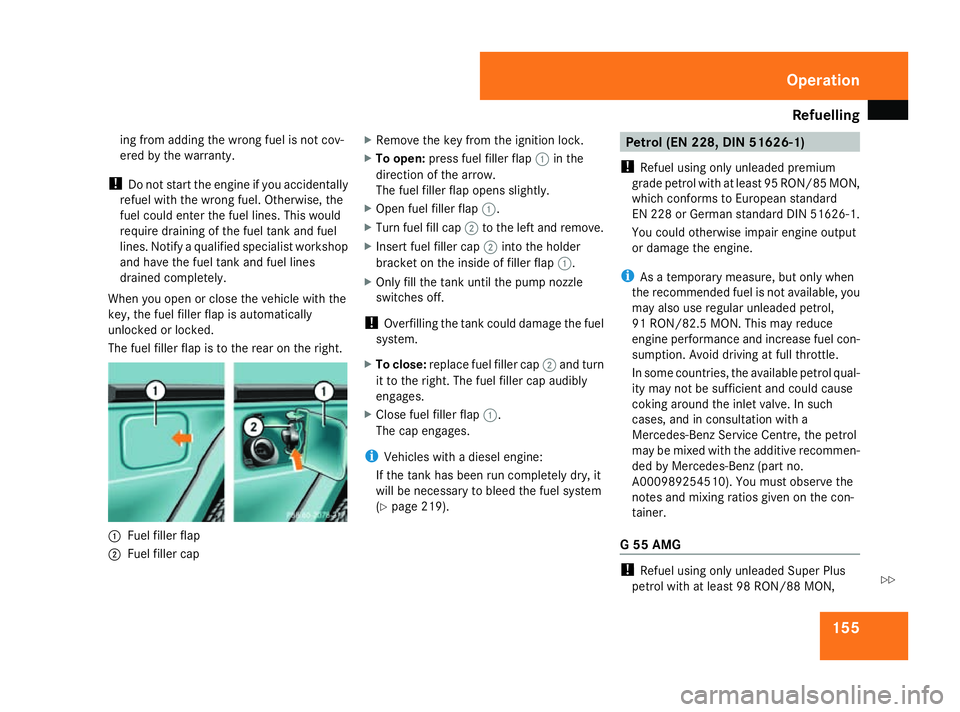
Refuelling
155
ing from adding the wrong fuel is not cov-
ered by the warranty.
! Do not start the engine if you accidentally
refuel with the wrong fuel. Otherwise, the
fuel could enter the fuel lines. This would
require draining of the fuel tank and fuel
lines. Notify a qualified specialist workshop
and have the fuel tank and fuel lines
drained completely.
When you open or close the vehicle with the
key, the fuel filler flap is automatically
unlocked or locked.
The fuel filler flap is to the rear on the right. 1
Fuel filler flap
2 Fuel filler cap X
Remove the key from the ignition lock.
X To open: press fuel filler flap 1in the
direction of the arrow.
The fuel filler flap opens slightly.
X Open fuel filler flap 1.
X Turn fuel fill cap 2to the left and remove.
X Insert fuel filler cap 2into the holder
bracket on the inside of filler flap 1.
X Only fill the tank until the pump nozzle
switches off.
! Overfilling the tank could damage the fuel
system.
X To close: replace fuel filler cap 2and turn
it to the right. The fuel filler cap audibly
engages.
X Close fuel filler flap 1.
The cap engages.
i Vehicles with a diesel engine:
If the tank has been run completely dry, it
will be necessary to bleed the fuel system
(Y page 219). Petrol (EN 228, DIN 51626-1)
! Refuel using only unleaded premium
grade petrol with at least 95 RON/85 MON,
which conforms to European standard
EN 228 or German standard DIN 51626-1.
You could otherwise impair engine output
or damage the engine.
i As a temporary measure, but only when
the recommended fuel is not available, you
may also use regular unleaded petrol,
91 RON/82.5 MO N. Thismay reduce
engine performance and increase fuel con-
sumption. Avoid driving at full throttle.
In some countries, the available petrol qual-
ity may not be sufficient and could cause
coking around the inlet valve. In such
cases, and in consultation with a
Mercedes-Benz Service Centre, the petrol
may be mixed with the additive recommen-
ded by Mercedes-Benz (part no.
A000989254510). You must observe the
notes and mixing ratios given on the con-
tainer.
G 55 AMG !
Refuel using only unleaded Super Plus
petrol with at least 98 RON/88 MON, Operation
463_AKB; 1; 8, en-GB
wobuchh
, Version: 2.10.6
2008-07-17T15:19:41+02:00 - Seite 155 ZDateiname: 6515_4091_02_buchblock.pdf; preflight
Page 165 of 293
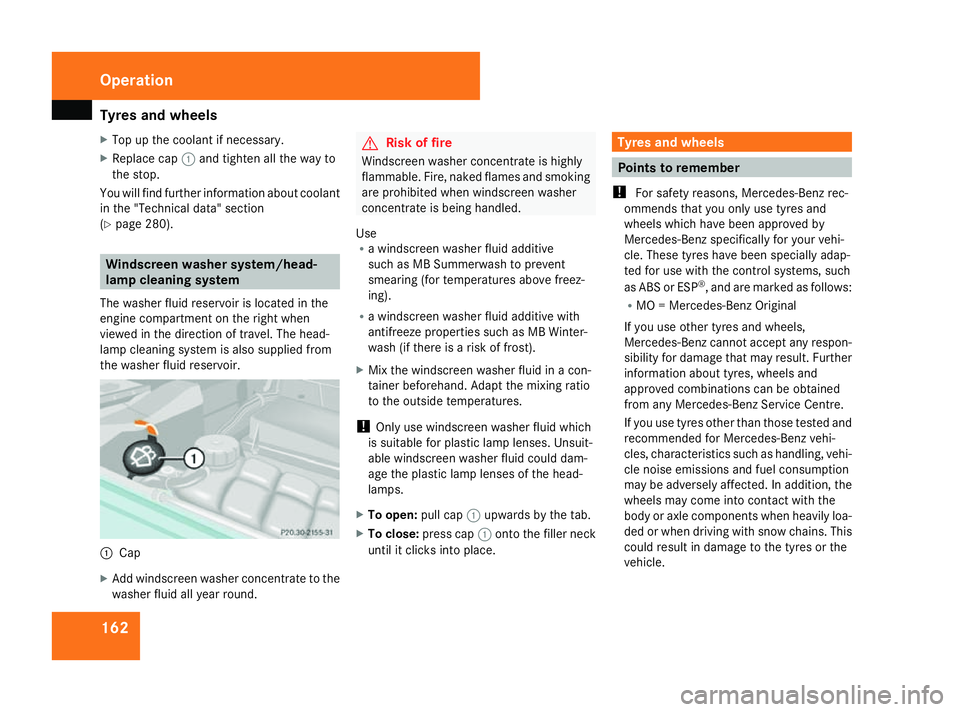
Tyres and wheels
162
X
Top up the coolant if necessary.
X Replace cap 1and tighten all the way to
the stop.
You will find further information about coolant
in the "Technical data" section
(Y page 280). Windscreen washer system/head-
lamp cleaning system
The washer fluid reservoir is located in the
engine compartment on the right when
viewed in the direction of travel. The head-
lamp cleaning system is also supplied from
the washer fluid reservoir. 1
Cap
X Add windscreen washer concentrate to the
washer fluid all year round. G
Risk of fire
Windscreen washer concentrate is highly
flammable. Fire, naked flames and smoking
are prohibited when windscreen washer
concentrate is being handled.
Use
R a windscreen washer fluid additive
such as MB Summerwash to prevent
smearing (for temperatures above freez-
ing).
R a windscreen washer fluid additive with
antifreeze properties such as MB Winter-
wash (if there is a risk of frost).
X Mix the windscreen washer fluid in a con-
tainer beforehand. Adapt the mixing ratio
to the outside temperatures.
! Only use windscreen washer fluid which
is suitable for plastic lamp lenses. Unsuit-
able windscreen washer fluid could dam-
age the plastic lamp lenses of the head-
lamps.
X To open: pull cap1upwards by the tab.
X To close: press cap 1onto the filler neck
until it clicks into place. Tyres and wheels
Points to remember
! For safety reasons, Mercedes-Benz rec-
ommends that you only use tyres and
wheels which have been approved by
Mercedes-Benz specifically for your vehi-
cle. These tyres have been specially adap-
ted for use with the control systems, such
as ABS or ESP ®
, and are marked as follows:
R MO = Mercedes-Benz Original
If you use other tyres and wheels,
Mercedes-Benz cannot accept any respon-
sibility for damage that may result. Further
information about tyres, wheels and
approved combinations can be obtained
from any Mercedes-Benz Service Centre.
If you use tyres other than those tested and
recommended for Mercedes-Benz vehi-
cles, characteristics such as handling, vehi-
cle noise emissions and fuel consumption
may be adversely affected. In addition, the
wheels may come into contact with the
body or axle components when heavily loa-
ded or when driving with snow chains. This
could result in damage to the tyres or the
vehicle. Operation
463_AKB; 1; 8, en-GB
wobuchh
, Version: 2.10.6 2008-07-17T15:19:41+02:00 - Seite 162Dateiname: 6515_4091_02_buchblock.pdf; preflight
Page 177 of 293
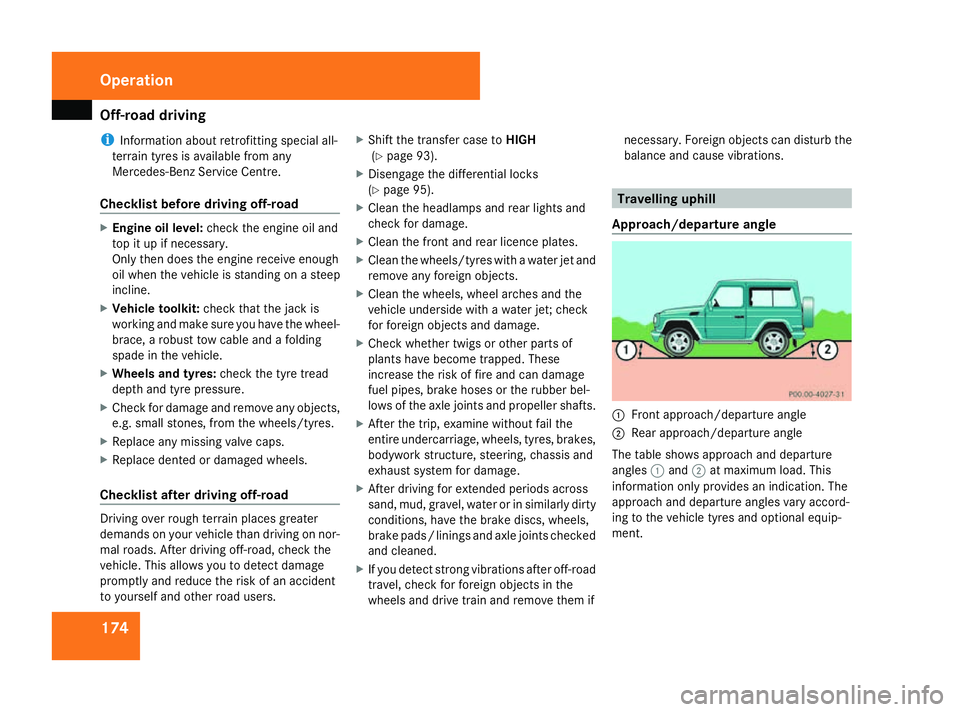
Off-road driving
174
i
Information about retrofitting special all-
terrain tyres is available from any
Mercedes-Benz Service Centre.
Checklist before driving off-road X
Engine oil level: check the engine oil and
top it up if necessary.
Only then does the engine receive enough
oil when the vehicle is standing on a steep
incline.
X Vehicle toolkit: check that the jack is
working and make sure you have the wheel-
brace, a robust tow cable and a folding
spade in the vehicle.
X Wheels and tyres: check the tyre tread
depth and tyre pressure.
X Check for damage and remove any objects,
e.g. small stones, from the wheels/tyres.
X Replace any missing valve caps.
X Replace dented or damaged wheels.
Checklist after driving off-road Driving over rough terrain places greater
demands on your vehicle than driving on nor-
mal roads. After driving off-road, check the
vehicle. This allows you to detect damage
promptly and reduce the risk of an accident
to yourself and other road users. X
Shift the transfer case to HIGH
(Y page 93).
X Disengage the differential locks
(Y page 95).
X Clean the headlamps and rear lights and
check for damage.
X Clean the front and rear licence plates.
X Clean the wheels/tyres with a water jet and
remove any foreign objects.
X Clean the wheels, wheel arches and the
vehicle underside with a water jet; check
for foreign objects and damage.
X Check whether twigs or other parts of
plants have become trapped. These
increase the risk of fire and can damage
fuel pipes, brake hoses or the rubber bel-
lows of the axle joints and propeller shafts.
X After the trip, examine without fail the
entire undercarriage, wheels, tyres, brakes,
bodywork structure, steering, chassis and
exhaust system for damage.
X After driving for extended periods across
sand, mud, gravel, water or in similarly dirty
conditions, have the brake discs, wheels,
brake pads /linings and axle joints checked
and cleaned.
X If you detect strong vibrations after off-road
travel, check for foreign objects in the
wheels and drive train and remove them if necessary. Foreign objects can disturb the
balance and cause vibrations. Travelling uphill
Approach/departure angle 1
Front approach/departure angle
2 Rear approach/departure angle
The table shows approach and departure
angles 1and 2at maximum load. This
information only provides an indication. The
approach and departure angles vary accord-
ing to the vehicle tyres and optional equip-
ment. Operation
463_AKB; 1; 8, en-GB
wobuchh,
Version: 2.10.6 2008-07-17T15:19:41+02:00 - Seite 174Dateiname: 6515_4091_02_buchblock.pdf; preflight
Page 182 of 293
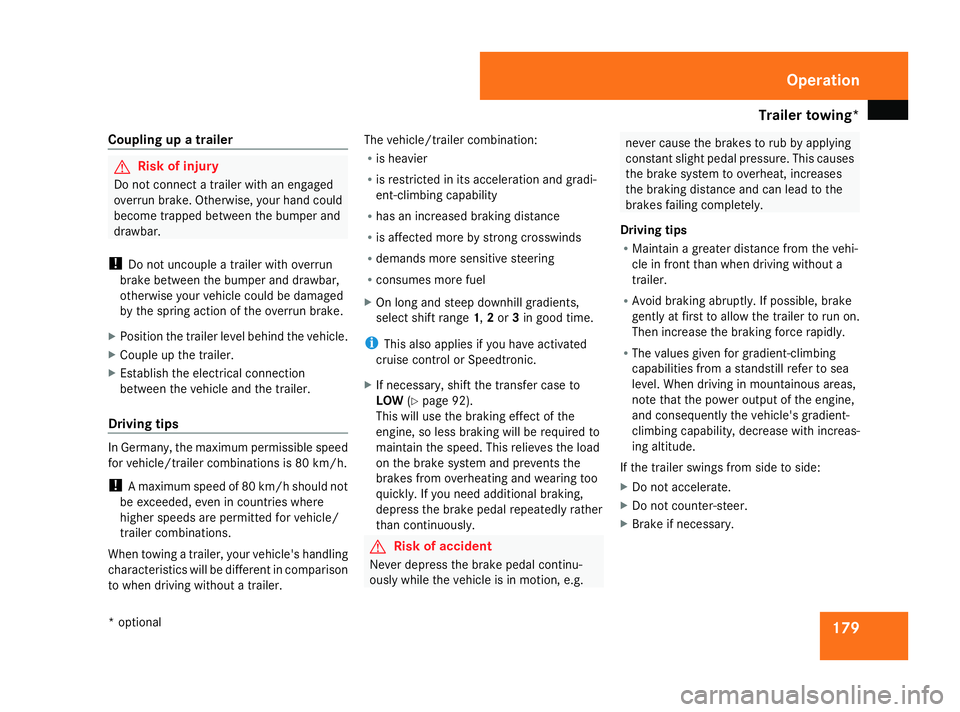
Trailer towing*
179
Coupling up a trailer G
Risk of injury
Do not connect a trailer with an engaged
overrun brake. Otherwise, your hand could
become trapped between the bumper and
drawbar.
! Do not uncouple a trailer with overrun
brake between the bumper and drawbar,
otherwise your vehicle could be damaged
by the spring action of the overrun brake.
X Position the trailer level behind the vehicle.
X Couple up the trailer.
X Establish the electrical connection
between the vehicle and the trailer.
Driving tips In Germany, the maximum permissible speed
for vehicle/trailer combinations is 80 km/h.
! A maximum speed of 80 km/h should not
be exceeded, even in countries where
higher speeds are permitted for vehicle/
trailer combinations.
When towing a trailer, your vehicle's handling
characteristics will be different in comparison
to when driving without a trailer. The vehicle/trailer combination:
R
is heavier
R is restricted in its acceleration and gradi-
ent-climbing capability
R has an increased braking distance
R is affected more by strong crosswinds
R demands more sensitive steering
R consumes more fuel
X On long and steep downhill gradients,
select shift range 1,2or 3in good time.
i This also applies if you have activated
cruise control or Speedtronic.
X If necessary, shift the transfer case to
LOW (Ypage 92).
This will use the braking effect of the
engine, so less braking will be required to
maintain the speed. This relieves the load
on the brake system and prevents the
brakes from overheating and wearing too
quickly. If you need additional braking,
depress the brake pedal repeatedly rather
than continuously. G
Risk of accident
Never depress the brake pedal continu-
ously while the vehicle is in motion, e.g. never cause the brakes to rub by applying
constant slight pedal pressure. This causes
the brake system to overheat, increases
the braking distance and can lead to the
brakes failing completely.
Driving tips
R Maintain a greater distance from the vehi-
cle in front than when driving without a
trailer.
R Avoid braking abruptly. If possible, brake
gently at first to allow the trailer to run on.
Then increase the braking force rapidly.
R The values given for gradient-climbing
capabilities from a standstill refer to sea
level. When driving in mountainous areas,
note that the power output of the engine,
and consequently the vehicle's gradient-
climbing capability, decrease with increas-
ing altitude.
If the trailer swings from side to side:
X Do not accelerate.
X Do not counter-steer.
X Brake if necessary. Operation
* optional
463_AKB; 1; 8, en-GB
wobuchh
,V ersion: 2.10.6
2008-07-17T15:19:41+02:00 - Seite 179 ZDateiname: 6515_4091_02_buchblock.pdf; preflight
Page 279 of 293
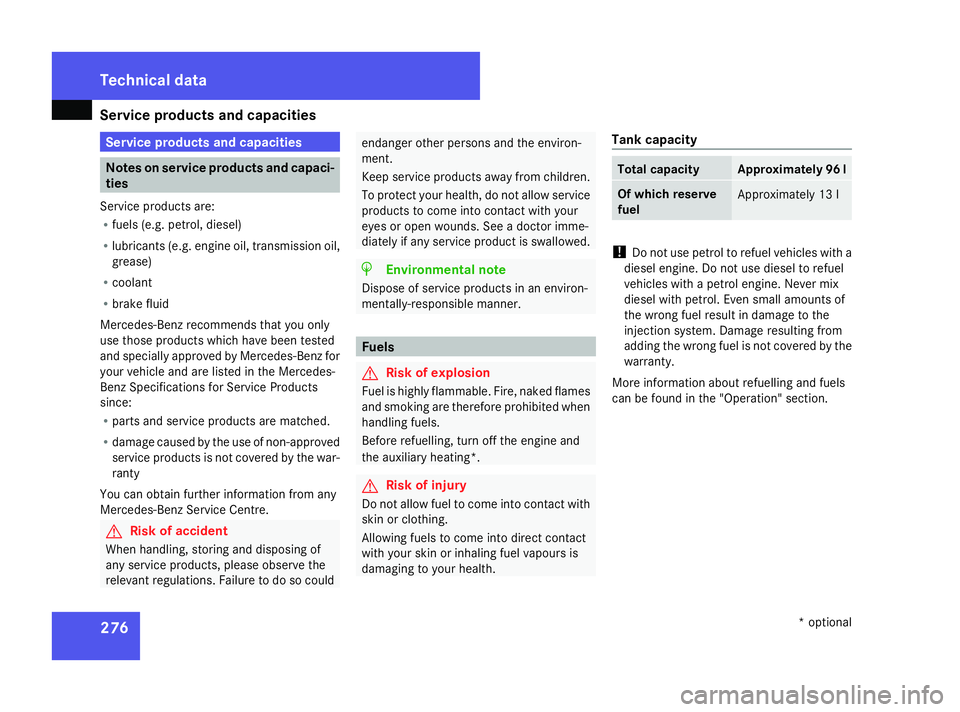
Service products and capacities
276 Service products and capacities
Notes on service products and capaci-
ties
Service products are:
R fuels (e.g. petrol, diesel)
R lubricants (e.g. engine oil, transmission oil,
grease)
R coolant
R brake fluid
Mercedes-Benz recommends that you only
use those products which have been tested
and specially approved by Mercedes-Benz for
your vehicle and are listed in the Mercedes-
Benz Specifications for Service Products
since:
R parts and service products are matched.
R damage caused by the use of non-approved
service products is not covered by the war-
ranty
You can obtain further information from any
Mercedes-Benz Service Centre. G
Risk of accident
When handling, storing and disposing of
any service products, please observe the
relevant regulations. Failure to do so could endanger other persons and the environ-
ment.
Keep service products away from children.
To protect your health, do not allow service
products to come into contact with your
eyes or open wounds. See a doctor imme-
diately if any service product is swallowed. H
Environmental note
Dispose of service products in an environ-
mentally-responsible manner. Fuels
G
Risk of explosion
Fuel is highly flammable. Fire, naked flames
and smoking are therefore prohibited when
handling fuels.
Before refuelling, turn off the engine and
the auxiliary heating*. G
Risk of injury
Do not allow fuel to come into contact with
skin or clothing.
Allowing fuels to come into direct contact
with your skin or inhaling fuel vapours is
damaging to your health. Tank capacity Total capacity Approximately 96 l
Of which reserve
fuel
Approximately 13 l
!
Do not use petrol to refuel vehicles with a
diesel engine. Do not use diesel to refuel
vehicles with a petrol engine. Never mix
diesel with petrol. Even small amounts of
the wrong fuel result in damage to the
injection system. Damage resulting from
adding the wrong fuel is not covered by the
warranty.
More information about refuelling and fuels
can be found in the "Operation" section. Technical data
* optional
463_AKB; 1; 8, en-GB
wobuchh,
Version: 2.10.6 2008-07-17T15:19:41+02:00 - Seite 276Dateiname: 6515_4091_02_buchblock.pdf; preflight
Page 280 of 293
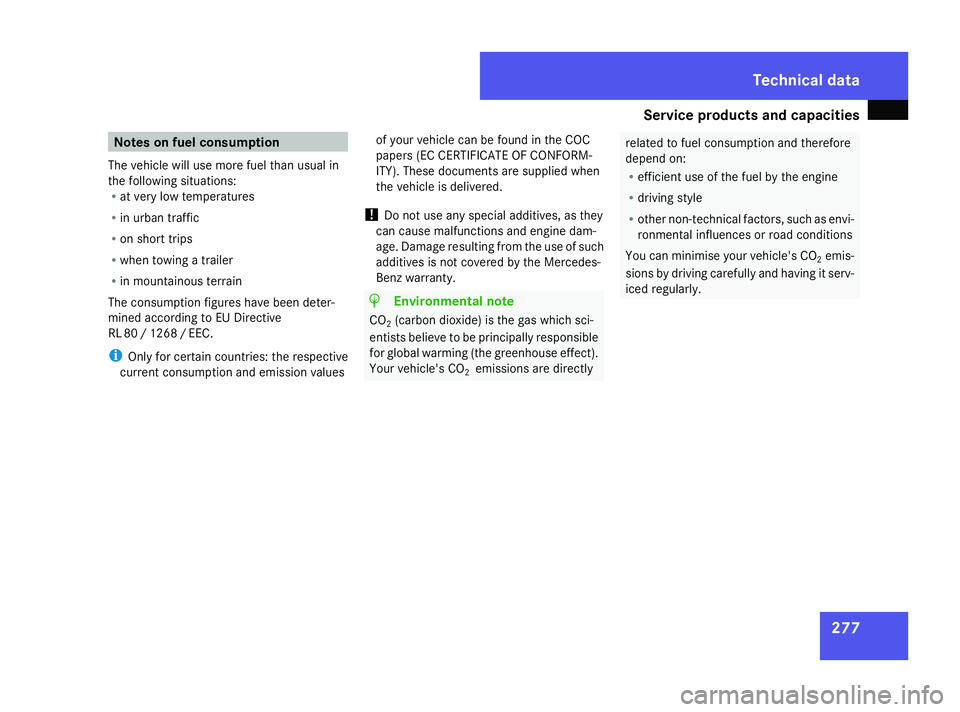
Service products and capacities
277Notes on fuel consumption
The vehicle will use more fuel than usual in
the following situations:
R at very low temperatures
R in urban traffic
R on short trips
R when towing a trailer
R in mountainous terrain
The consumption figures have been deter-
mined according to EU Directive
RL 80 /1268 /EEC.
i Only for certain countries: the respective
current consumption and emission values of your vehicle can be found in the COC
papers (EC CERTIFICATE OF CONFORM-
ITY). These documents are supplied when
the vehicle is delivered.
! Do not use any special additives, as they
can cause malfunctions and engine dam-
age. Damage resulting from the use of such
additives is not covered by the Mercedes-
Benz warranty. H
Environmental note
CO 2(carbon dioxide) is the gas which sci-
entists believe to be principally responsible
for global warming (the greenhouse effect).
Your vehicle's CO 2emissions are directly related to fuel consumption and therefore
depend on:
R
efficient use of the fuel by the engine
R driving style
R other non-technical factors, such as envi-
ronmental influences or road conditions
You can minimise your vehicle's CO 2emis-
sions by driving carefully and having it serv-
iced regularly. Technical data
463_AKB; 1; 8, en-GB
wobuchh
,V ersion: 2.10.6
2008-07-17T15:19:41+02:00 - Seite 277 ZDateiname: 6515_4091_02_buchblock.pdf; preflight
Page 281 of 293
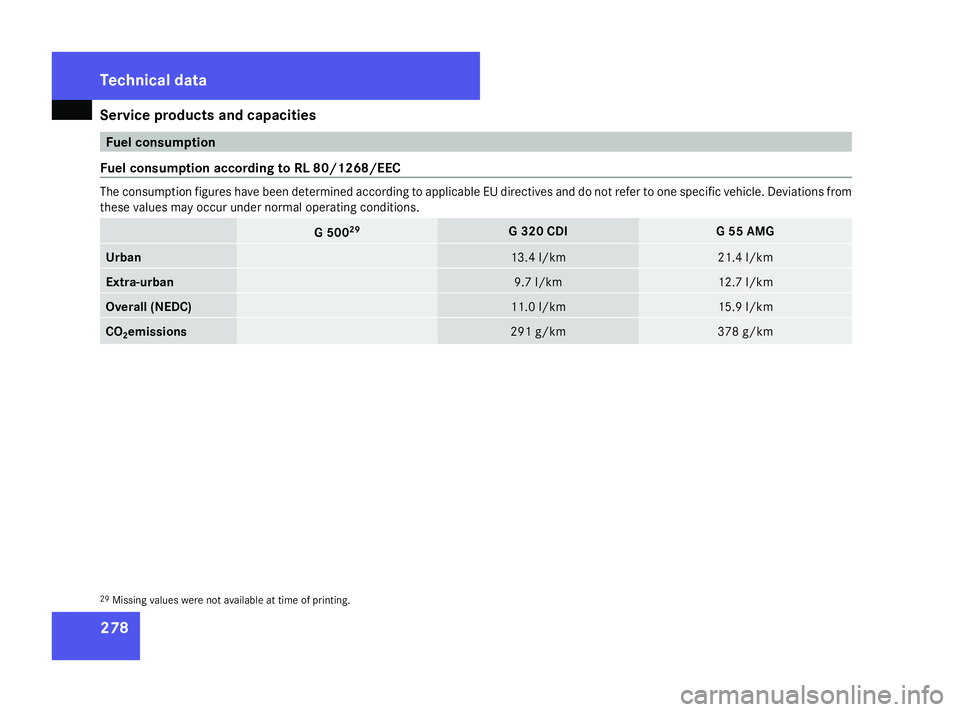
Service products and capacities
278 Fuel consumption
Fuel consumption according to RL 80/1268/EEC The consumption figures have been determined according to applicable EU directives and do not refer to one specific vehicle. Deviations from
these values may occur under normal operating conditions. G 500
29 G 320 CDI G 55 AMG
Urban
13.4 l/km 21.4 l/km
Extra-urban
9.7 l/km 12.7 l/km
Overall (NEDC)
11.0 l/km 15.9 l/km
CO
2emissions 291 g/km 378 g/km
29
Missing values were not available at time of printing. Technical data
463_AKB; 1; 8, en-GB
wobuchh,
Version: 2.10.6 2008-07-17T15:19:41+02:00 - Seite 278Dateiname: 6515_4091_02_buchblock.pdf; preflight